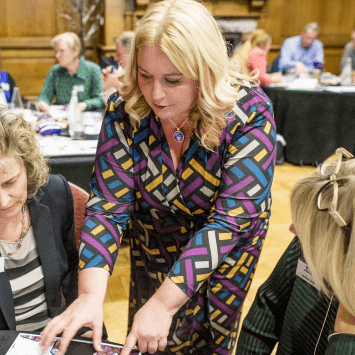Posted in Blog, Create, Grow, Influencing people, Lead Your Team by Jo North
Hello and welcome to this article on Appreciative Inquiry, a Guide for Workshop Facilitators.
I cover what Appreciative Inquiry is and show you how you could use the process of Appreciative Inquiry to create and facilitate a highly effective, strengths-focused workshop for your delegates.
If you’d like to download my free Appreciative Inquiry toolkit for facilitators, it’s here in my online Content Studio. Just scroll down to the Facilitation Toolkits section and you’ll find it there.
What is Appreciative Inquiry?
Appreciative Inquiry means recognising, exploring and building on the positive, aligning with strengths-based development.
Appreciative Inquiry is all about reframing, and, starting from the position of asking, ‘What are we doing well?’, ‘What are the good things?’, ‘What are we great at?’, ‘What are the positives that we have got to offer?’
Having a positive focus is optimistic, empowering and motivational, and for these reasons Appreciative Inquiry can be a powerful ingredient for achieving positive change.
If you want to learn more about the academic theory behind Appreciative Inquiry, the work of David Cooperrider is definitely the place to start.
My focus in this article is on how to make that theory work in practice, with a whole agenda for an Appreciative Inquiry-based workshop, including tools, techniques and activities that you can use.
Start with the positives
The positives are so important as a starting point because our energy and efforts go in the same direction as our thoughts. So, if we are thinking about building on strengths then that is where our decisions and our actions will go. We will make our strengths stronger, we will be able to stand out. We will be able to do bigger and better things.
In Appreciative Inquiry we start with the positives, and we think about what we can do, what is possible and take it from there. By changing the language we use, we change our intent, and we change the direction of our actions.
That is in contrast with a problem-focused starting point . I am all for a problem-focused starting point sometimes, because that is where a lot of great entrepreneurial ideas come from. It’s a question of using the most appropriate approach for your workshop.
The Appreciative Inquiry process
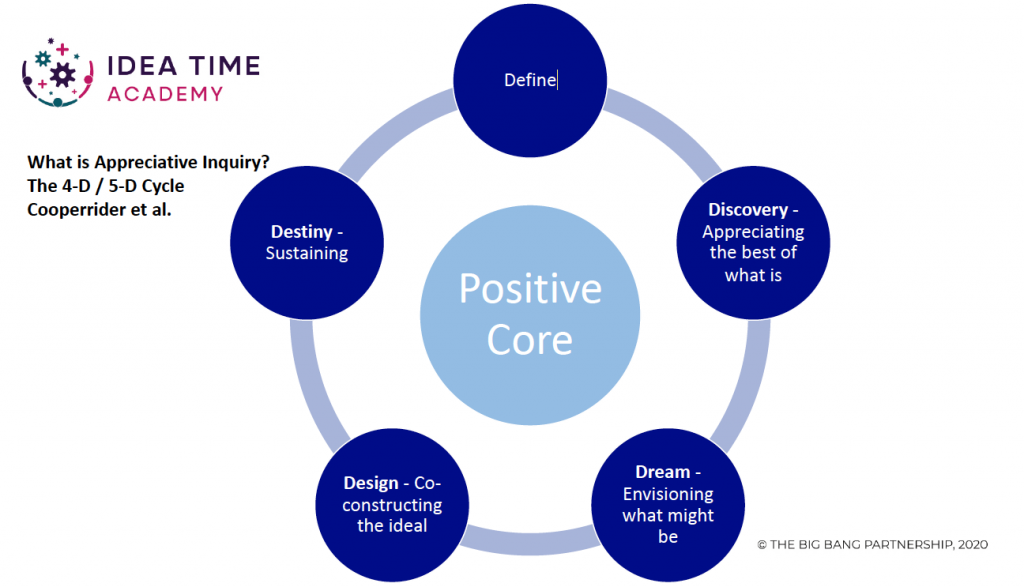
The Appreciative Inquiry process is a continuous cycle made up of 4 or 5 key stages, depending on the version of the model you’re using. This model is called the 4-D or 5-D model, because the name of each stage begins with the letter ‘D’. I’m going to use the 5-D model here so that you have a complete view.
The process starts with Define, to think about the challenge at hand and decide what you want to work on.
Stage two is Discovery. The task at this stage is to see and appreciate the best of t the positives in the current situation to define the starting point for the rest of the process.
The next stage is the Dream phase. This involves using imagination to explore what might be possible in the future.
After that comes the Design phase. The focus here is to create a map to get from the current starting point to the new, aspirational future.
Finally, the Destiny element of the process is all about sustaining it, making the transformation happen and keeping it going.
Define, Discovery, Dream, Design, Destiny
A great approach is to use each of the 5-D Model stages, Define, Discovery, Dream, Design and Destiny, as the backbone of your agenda for your facilitation workshop.
Define
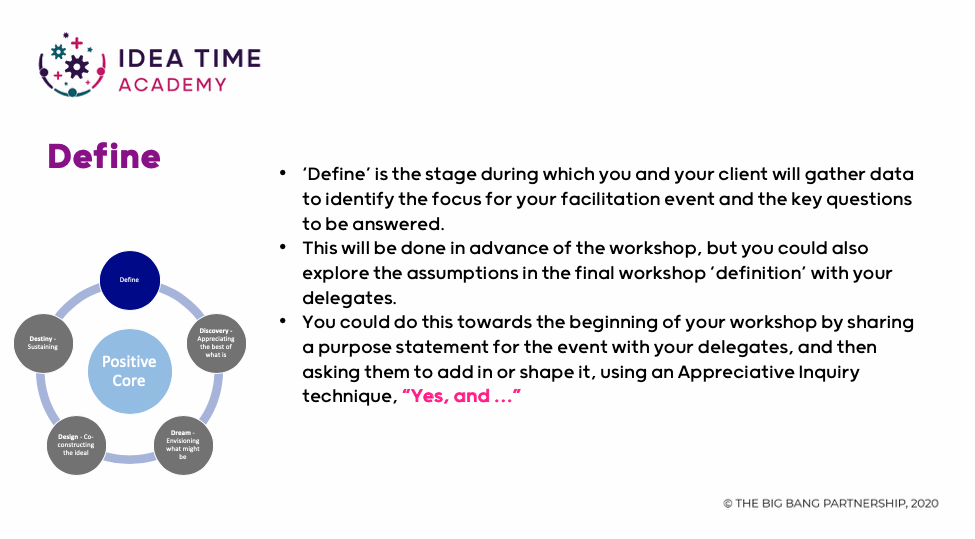
Define is the stage during which you and your client will gather data to identify the focus for your facilitation event and the key questions to be answered.
This will be done in advance of the workshop, but you could also explore the assumptions in the final workshop ‘definition’ with your delegates.
You could do this towards the beginning of your workshop by sharing a purpose statement for the event with your delegates, and then asking them to add in or shape it, using an Appreciative Inquiry technique, “Yes, and …”.
Yes, and…
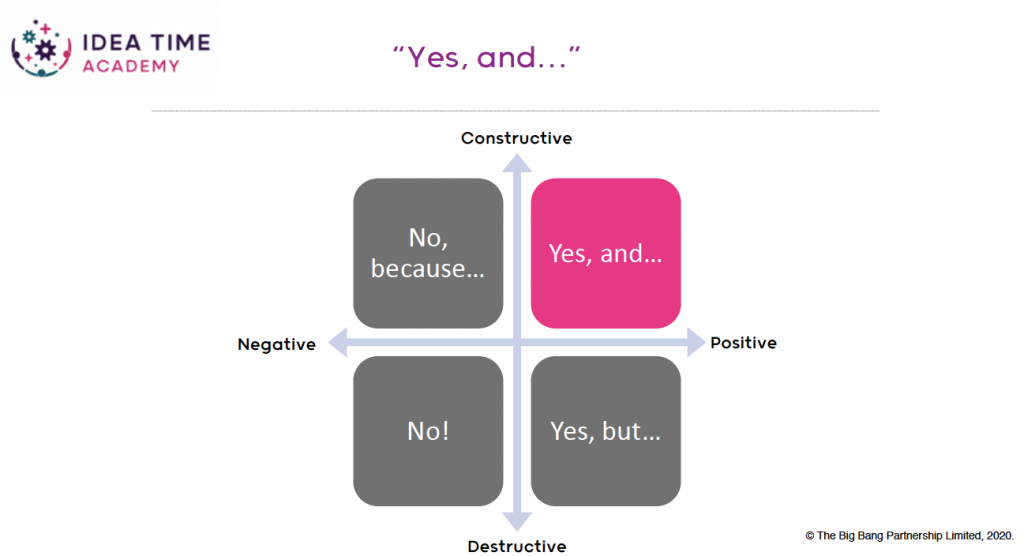
The language you choose to use throughout your Appreciative Inquiry process is really important. “Yes, and…” is a nice way of building on somebody’s ideas.
All too often, when someone has an idea, we say, or others respond with “Yes, but…”
The word ‘but’ dismisses everything that has gone before in that sentence. So when we say “Yes, but…” we are in effect dismissing what the other person has said.
When we say “Yes, and…” we are actually acknowledging what the other person has said, demonstrating that we are building on it. That is a very subtle shift isn’t it? But it does make a subconscious difference to how people will feel about the conversations that you are having.
Wherever you can use “Yes, and…”
Discovery
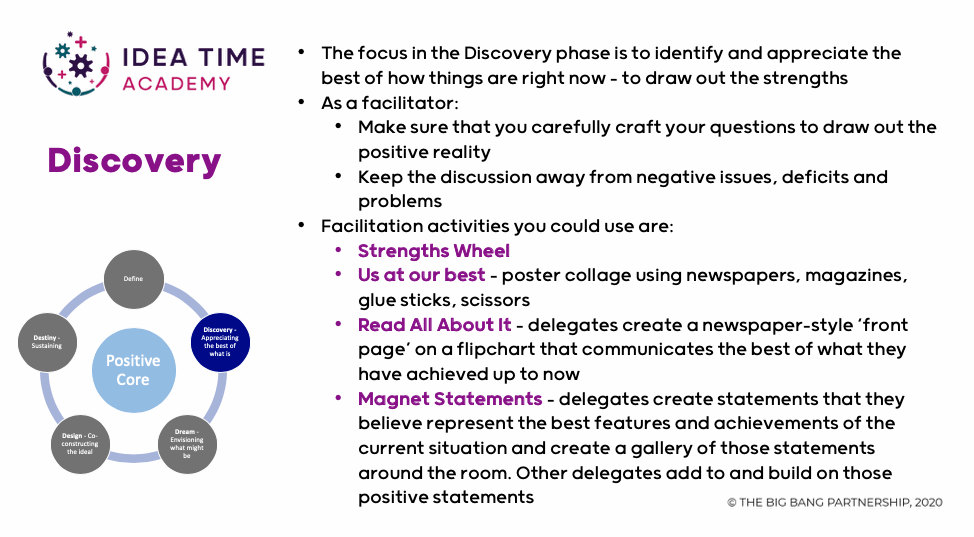
Let’s move on now to the content of your facilitation session with the Discovery stage.
As a facilitator, make sure that you carefully craft your questions to draw out the positive, current reality. Keep the discussion away from negative issues, deficits and problems.
Facilitation activities you could use include:
•The strengths wheel
•Us at our best
•Read all about it
•Magnet statements
I’ll explain each of these in turn now.
Strengths wheel
We all have strengths, but sometimes don’t use them, or don’t get the opportunity to use our strengths fully.
Ask delegates to think about, identify, and write down all their current strengths. Then ask them to consider how much they use those strengths. Invite delegates to reflect on how much scope they have to make more of their strengths. You could use a template like the one shown here, which you can download for free as part of my Appreciative Inquiry for Facilitators toolkit here.
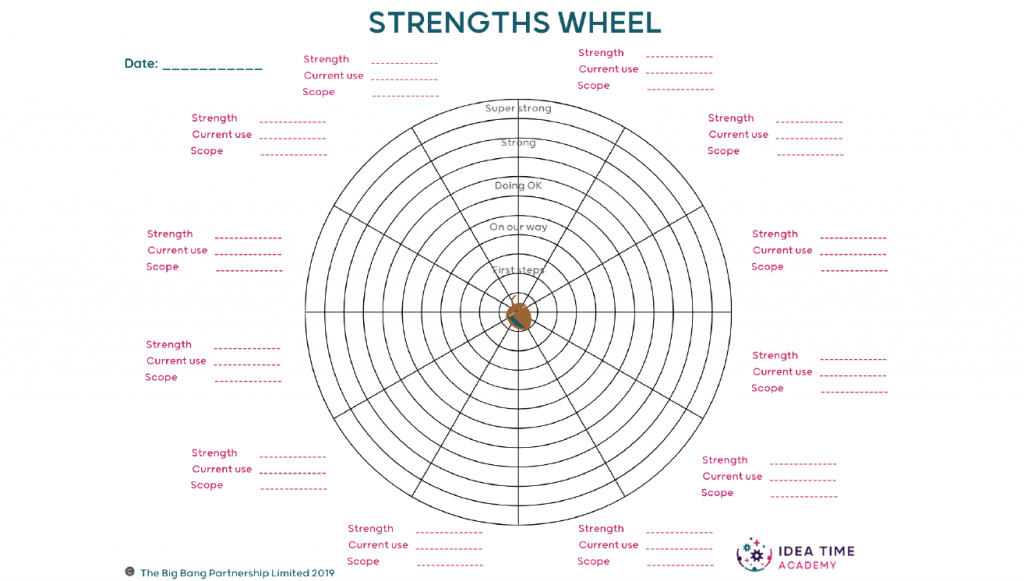
Us at our best
Another technique for the Discovery phase is to ask delegates to think about when they are at their best and create a poster collage using old newspapers and magazines to explore and visualise that.
Read all about it
Delegates create a newspaper-style ‘front page’ on a flip chart that communicates the very best of what they have achieved up to now.
Magnet statements
Delegates create statements that they believe represent the best features and achievements of the current situation and create a gallery of those statements around the room. Other delegates add to and build on those positive statements.
For instance, if somebody puts a statement on the wall which reads, ‘We are number one in our industry for customer experience, and all our statistics show that’, then somebody else might add in another item which supports that customer experience is excellent.
These are called magnet statements because they are positive, and attract even more positivity.
Dream
Once delegates have completed the Discovery phase, then it is time to move on the Dream stage. The Dream phase is about imagination, possibility and aspiration.
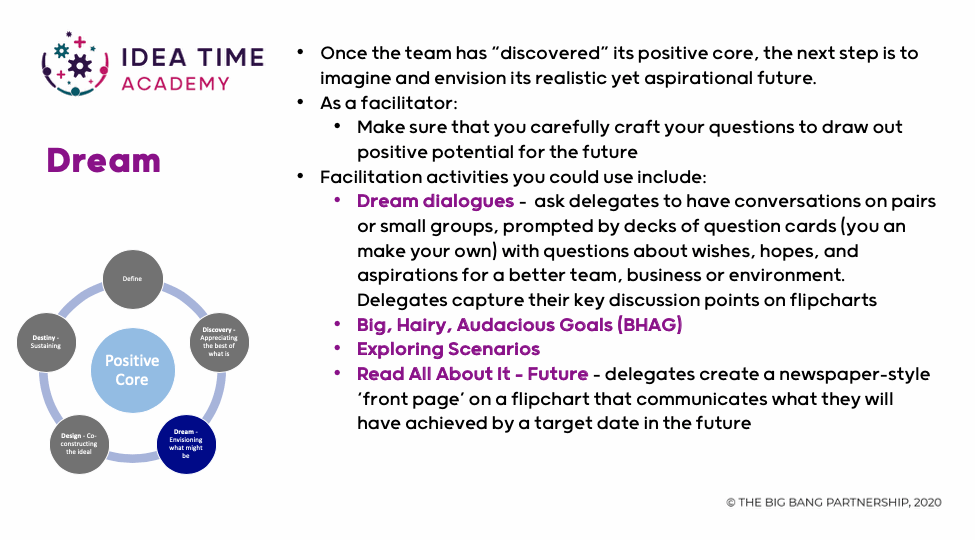
Some of the activities you could use for this part of your facilitation agenda are:
•Dream dialogues
•Big, Hairy, Audacious Goals (BHAGs)
•Exploring scenarios
•Read all about it – future
Dream dialogues
Ask delegates to have conversations in pairs or small groups, prompted by decks of question cards (you can make your own) with questions about wishes, hopes, and aspirations for a better team, business or environment.
Delegates capture their key discussion points on flip charts and then feedback in plenary.
This is a great facilitation technique because it gets people talking and sharing their ideas.
Big, Hairy, Audacious Goals (BHAGs)
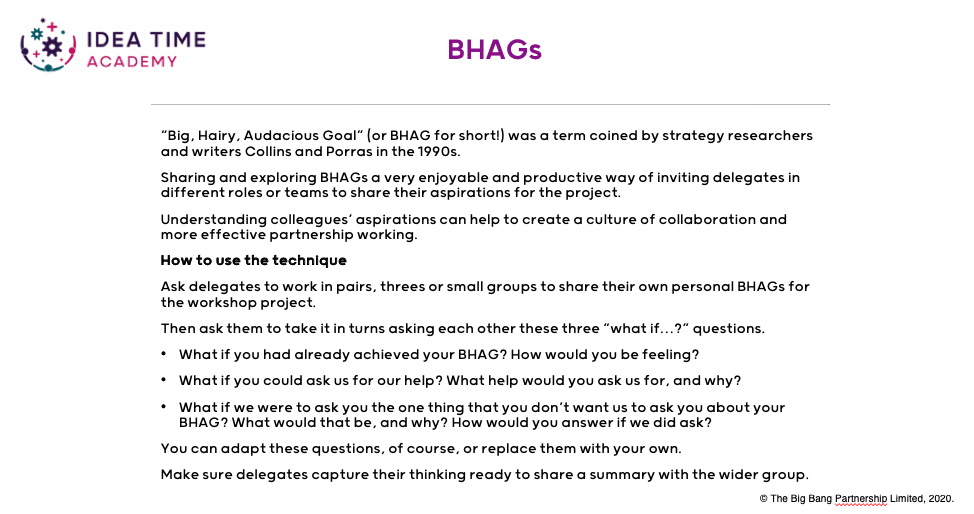
“Big, Hairy, Audacious Goal”, (or “BHAG” for short!), was a term coined by strategy researchers and writers Collins and Porras in the 1990s.
Sharing and exploring BHAGs an enjoyable and productive way of inviting delegates in different roles or teams to share their aspirations for the project.
Understanding colleagues’ aspirations can help to create a culture of collaboration and more effective partnership working.
How to use the technique
Ask delegates to work in pairs, threes or small groups to share their own personal BHAGs for the workshop project.
Then ask them to take it in turns asking each other these “What if…?” questions:
- What if you had already achieved your BHAG? How would you be feeling?
- What if you could ask us for our help? What help would you ask us for, and why?
- What if we were to ask you the one thing that you don’t want us to ask you about your BHAG? What would that be, and why? How would you answer if we did ask?
You can adapt these questions, of course, or replace them with your own.
Make sure delegates capture their thinking ready to share a summary with the wider group.
Exploring scenarios
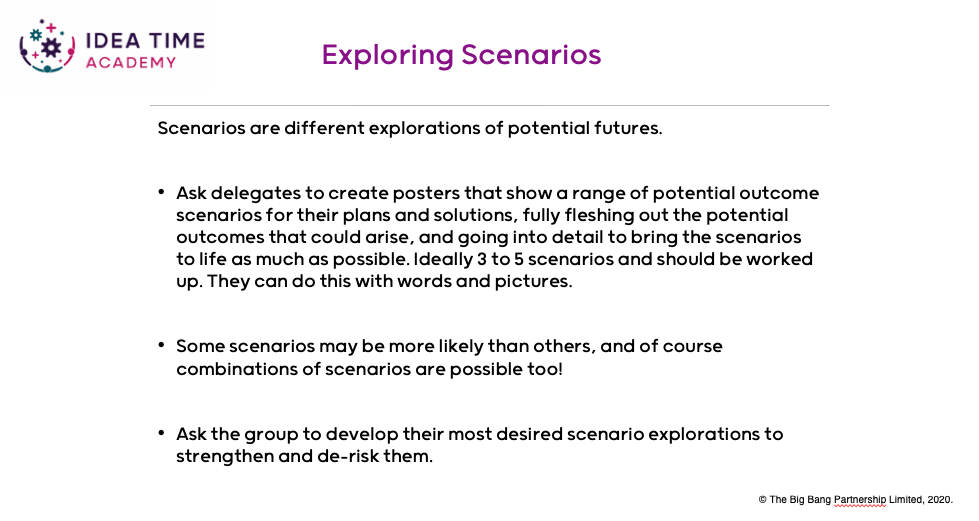
In Exploring scenarios you ask delegates to explore scenarios about the potential future. They create posters, and think about different options and would could happen as a result of those options in the future.
Encourage delegates to go into as much detail with their potential scenarios as possible using words and pictures, and identify 3-5 scenarios to work up.
Some scenarios will be more probable than others, and of course combinations of scenarios are possible too.
Finally, ask the group to develop their most desired scenario explorations to strengthen them and de-risk them.
Design
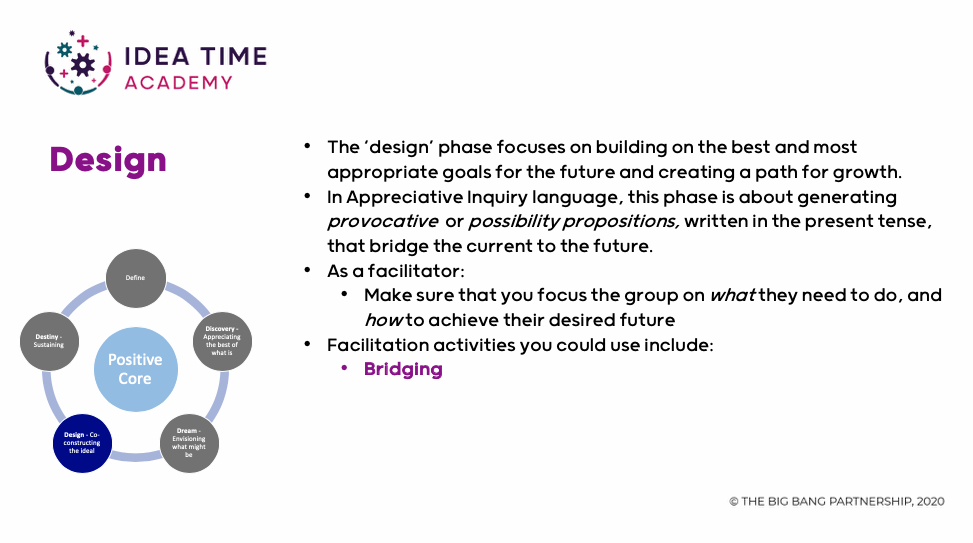
The Design phase is all about thinking about the goals for the future. You have done some work on the possibilities, and now it is about starting to work on how you are going to achieve those possibilities, and making that big vision more tangible, realistic and deliverable. The Bridging technique is a good one to use here.
Bridging technique
Ask delegates to list all their most important goals and aspirations from the Dream phase into the left-hand column of a table, such as the one shown here.
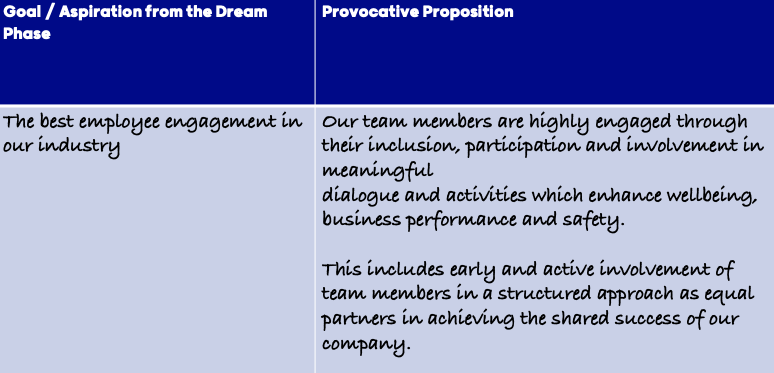
Then, in the right-hand column, ask them to create a provocative proposition for each goal or aspiration that summarises what they need to do to move forward. The provocative proposition is to be written in the present tense, positively stated, be a stretch and inspire the delegates, such as the one shown in the example above.
That is a really nice thing to do, and it’s a really important thing because, it is sometimes a big jump to go from ‘well that is a big imaginative vision’ through to ‘how do we deal with that then’. A bridging phase helps you towards that. Then you can get more onto the nitty gritty with the Destiny phase.
Destiny
The Destiny phase is about more detailed planning and generating collective commitment to making the transformation happen. When you’re facilitating, make sure that you focus the group on getting buy-in and creating a shared action plan.
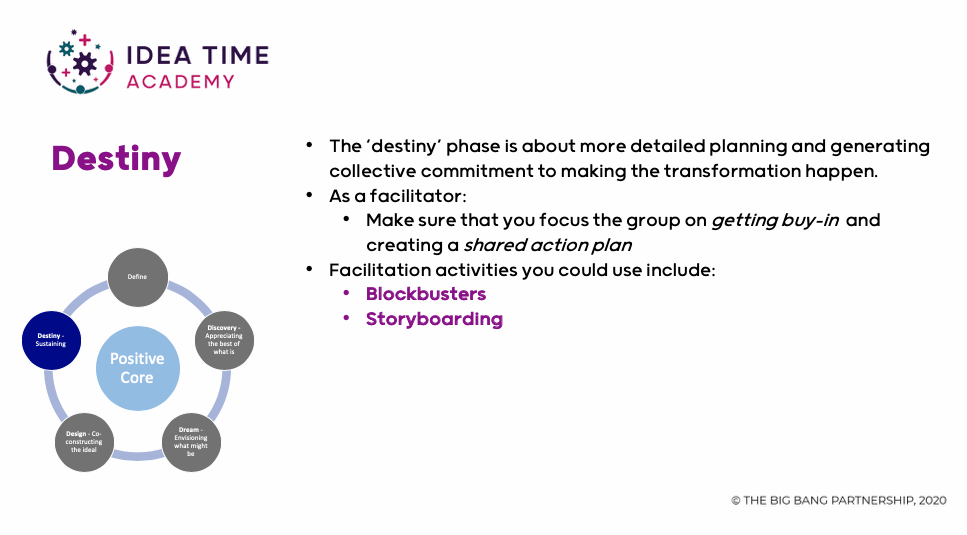
The two activities are Blockbusters, and Storyboarding.
Blockbusters
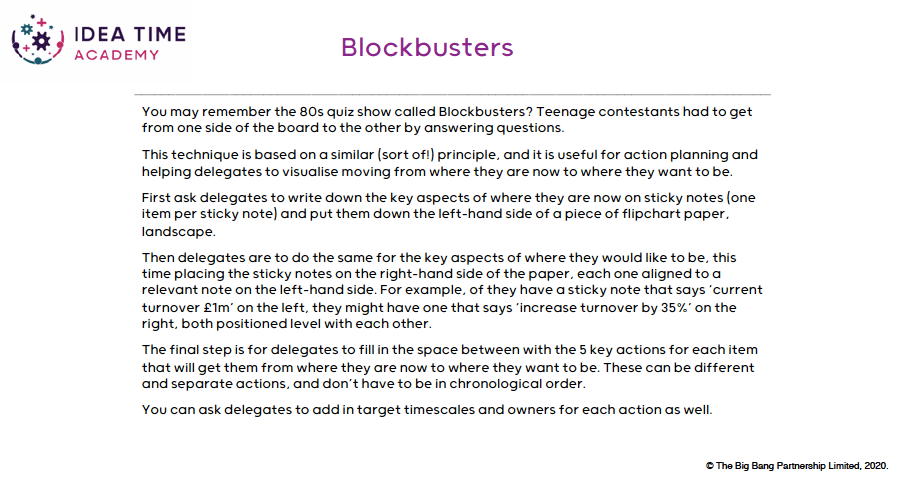
You may remember the 80s quiz show called Blockbusters? Teenage contestants had to get from one side of the board to the other by answering questions.
This technique is based on a similar (sort of!) principle, and it is useful for action planning and helping delegates to visualise moving from where they are now to where they want to be.
First ask delegates to write down the key aspects of where they are now on sticky notes (one item per sticky note) and put them down the left-hand side of a piece of flip chart paper, landscape orientation.
Then delegates are to do the same for the key aspects of where they would like to be, this time placing the sticky notes on the right-hand side of the paper, each one aligned to a relevant note on the left-hand side. For example, if they have a sticky note that says ‘current turnover £1m’ on the left, they might have one that says ‘increase turnover by 35%’ on the right, both positioned level with each other.
The final step is for delegates to fill in the space between with the 5 key actions for each item that will get them from where they are now to where they want to be. These can be different and separate actions, and don’t have to be in chronological order.
You can ask delegates to add in target timescales and owners for each action as well.
Storyboarding
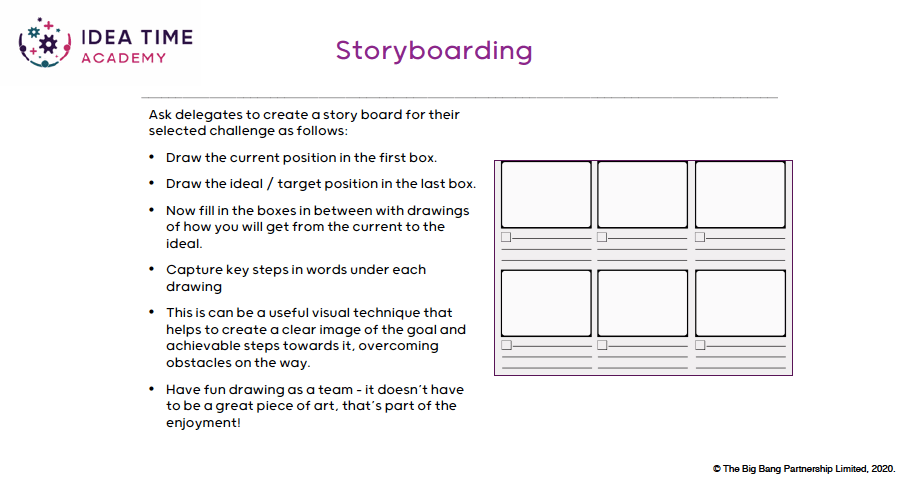
Ask delegates to create a story board for their selected challenge as follows:
•Draw the current position in the first box.
•Then sketch the ideal / target position in the last box. •Now fill in the boxes in between with drawings of how you will get from the current to the ideal.
•Capture key steps in words under each drawing.
This can be a useful visual technique that helps to create a clear image of the goal and achievable steps towards it, overcoming obstacles on the way.
Have fun drawing as a team – it doesn’t have to be a great piece of art, that’s part of the enjoyment!
Turning challenges into opportunities
When you are facilitating using the Appreciative Inquiry method, remember to stay with the positives opportunities. Turn weaknesses into scope for improvement, risks into opportunities. Create an environment that supports a really positive, can-do mindset.
If you only ever work in the problem solving space you won’t shine or stand out as much as you could. Often you do need to focus on problem-solving, but it’s also important to spend time thinking about where you are really strong. That means you can take things to the next level, achieve excellence, have competitive advantage and so on, because you are building on those strengths. Strengths need your time, attention and development, too. Appreciative Inquiry is a truly great process for focusing on strengths.
Free Appreciative Inquiry for Facilitators Toolkit
If you’d like to download my free Appreciative Inquiry toolkit for facilitators, it’s here in my online Content Studio. Just scroll down to the Facilitation Toolkits section and you’ll find it there.
You might also like to listen to my podcast episode on Appreciative Inquiry here.
More Background Reading
Origins and Principles of Appreciative Inquiry
Appreciative Inquiry, rooted in the work of David L. Cooperrider from Case Western Reserve University, represents a significant shift in organizational change methods. Developed within the Weatherhead School of Management, Appreciative Inquiry moves away from traditional deficit-based approaches, focusing instead on leveraging the positive core of human systems.
The 5-D Cycle of Appreciative Inquiry
Define Phase
The journey starts with the Define phase. Here, the broad scope of the inquiry is established, focusing on strengths and setting a positive direction for subsequent stages.
Discovery Phase
In the Discovery phase, team members and community participants delve into past successes. Through appreciative interviews, they unearth the organization or community’s positive potential. These conversations offer a holistic view, driving an infusion of positive emotions.
Dream Phase
The Dream phase follows, where participants visualize a better future, grounded in their shared positive experiences. This stage fosters a collective vision, channeling the speed of imagination.
Design Phase
The Design phase then transforms this shared vision into actionable strategic plans. Participants craft compelling statements of strategic intent, aligning plans with the positive core identified in the Discovery phase.
Destiny Phase
Finally, the Destiny phase actualizes the desired future. Continuous improvement and adaptation characterize this stage, as new insights emerge from the preceding phases.
Best Practices and Applications
Cooperrider, also Diana Whitney, Ronald Fry and others, have documented numerous case studies and guides, highlighting the effectiveness of Appreciative Inquiry across various sectors, including the United States Navy and British Airways. These studies demonstrate the transformative potential of Appreciative Inquiry in areas like leadership development, community building, and boosting competitiveness.
The Power of Positive Perspective
At its heart, Appreciative Inquiry emphasizes a strength-based viewpoint. This contrasts starkly with many conventional methods, which start with problem identification. Appreciative Inquiry, instead, begins with affirmative topic choices, spotlighting positive aspects.
Broad Applications
Appreciative Inquiry’s principles resonate beyond organizational boundaries. Community leaders, clinical nurse leaders, and others have tapped into its power to foster collaborative cultures and instigate transformational change. By emphasizing shared experiences and focusing on strengths, entities like British Airways have enhanced their customer service and overall work environment.
Conclusion
In essence, Appreciative Inquiry provides a refreshing lens, changing not just organizational narratives but also reshaping how we perceive challenges and opportunities. Pioneered by figures like Cooperrider, Whitney, and Fry, it underscores the potential of a positive, forward-thinking approach in crafting a prosperous future.

